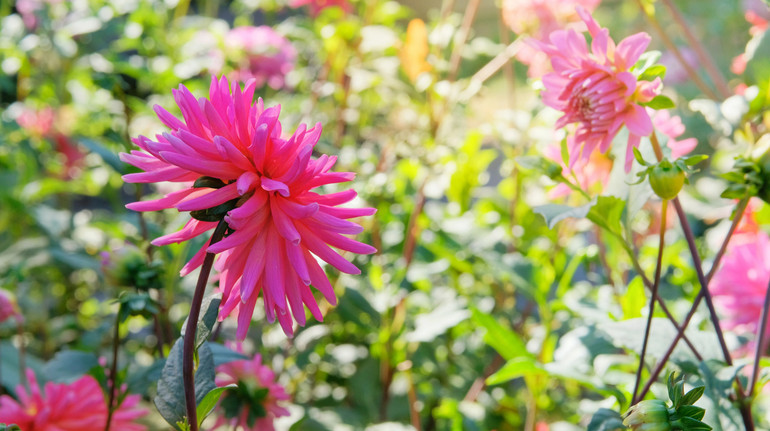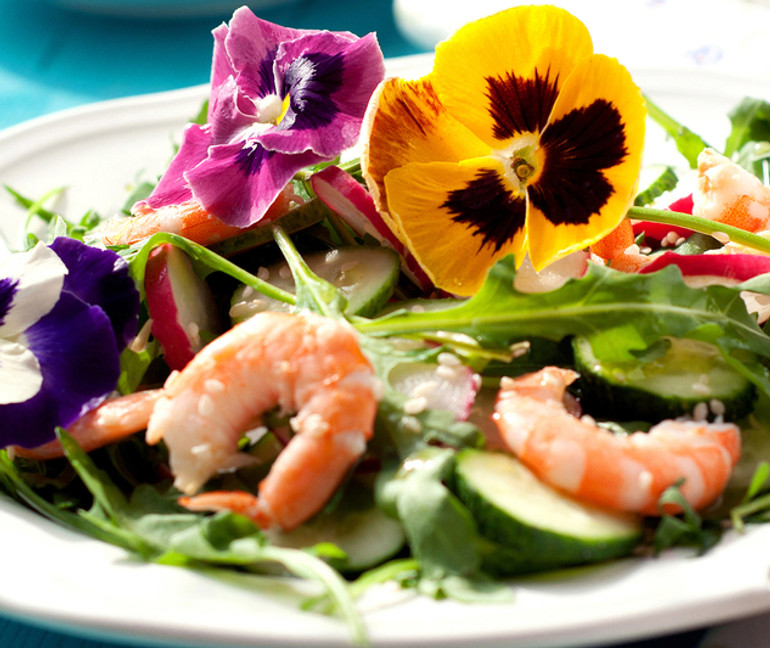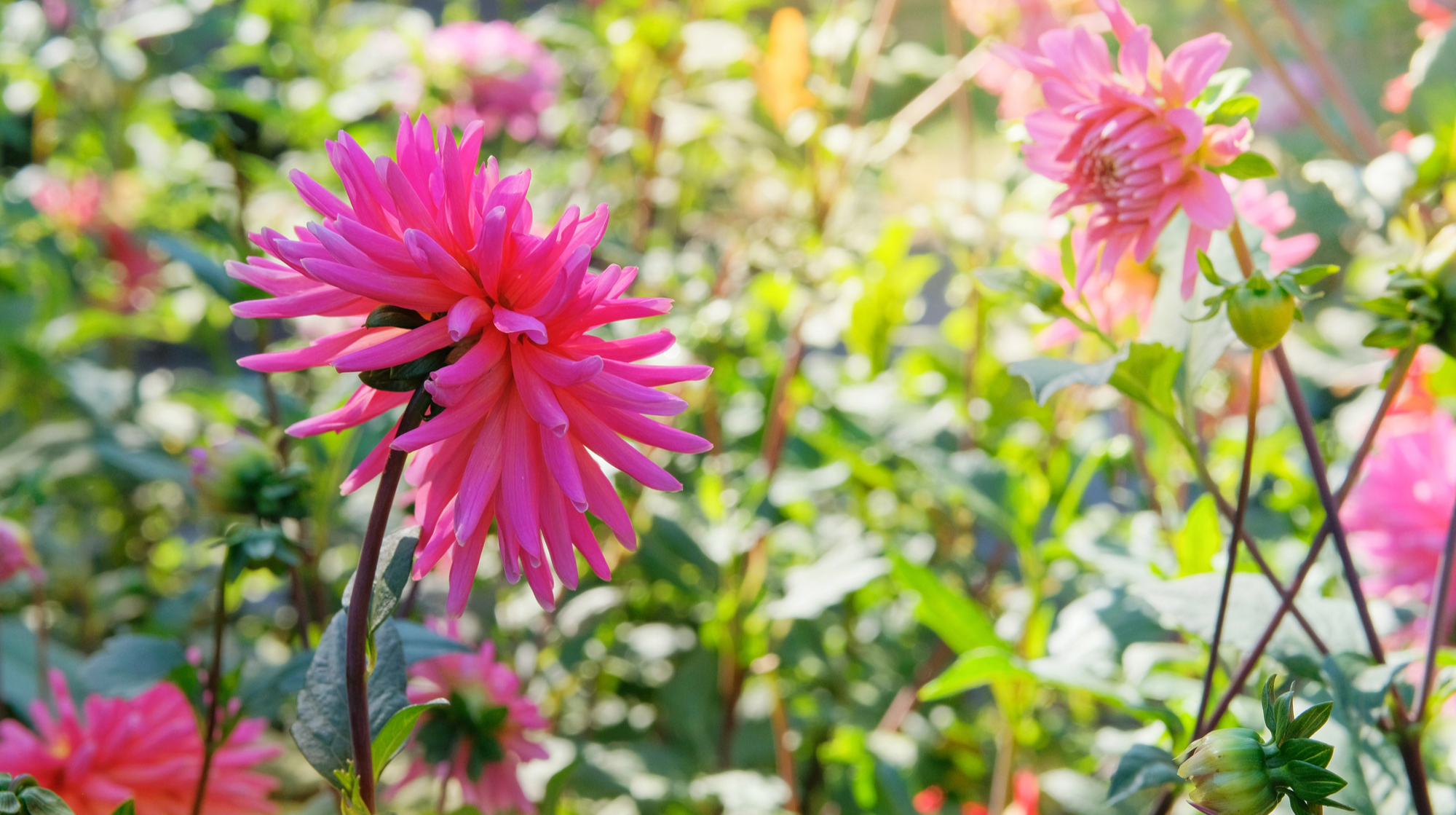“
 Dahlias die at the slightest frost
Dahlias die at the slightest frost
Photo: Ga_Na/Depositphotos
For example, begonia and fuchsia cannot withstand frost, cannas die at the slightest cooling, instead, tulips are better planted in autumn.
So which flowers do not tolerate frost, when to dig them up and how to store them properly, the biologist told Yury Bengus.
What flowers should be dug up in autumn? Autumn is an important period for digging up flower bulbs to ensure their health and viability, it is said at BackyardBoss.
Bulbs left in the ground can rot due to high humidity and frost.
Digging also makes it possible to separate overcrowded bulbs, promoting their healthy growth in the next season.
After digging the bulbs should be created optimal conditions for their storage: in a cool, dry and dark place.
“Flowers of tropical origin cannot withstand frosts. Chlorophytum, setcreasia, begonia, pelargonium, fuchsia and other heat-loving flowers should be moved indoors before frost.” – says Yuriy Bengus.
Dahlias and cannas die at the slightest frost, so their tubers and rhizomes should be dug up after the first frosts, when the leaves have already frozen and the soil has not yet frozen.
Bulbs instead tulips it is better to plant in autumn, they are not afraid of frost. It is the same with hyacinths, but after planting their bulbs, it is worth mulching the soil with dry leaves or larch, because they are not as frost-resistant as tulips.
To understand what time is optimal for digging flower bulbs, you need to monitor the weather in your area. In different regions of Ukraine, the first frosts come at different times.
About whether to expect frost and what the weather will be like in the second half of October, read on “UP. Life”.

How to prepare and store dug flowers in winter? Each type of flower has its own “recipes”, for example, dahlias are stored at a temperature of 3-5 degrees, cannas – 10-12.
“It is not necessary to shake the ground from the cann rhizome. It is better to put it in a box and sprinkle with sawdust or sand. In the spring, before planting, the cann rhizomes germinate and they are exposed in the boxes to the light.” – says the biologist.
Flowers that do not have a rest period should be carefully dug up with the remaining soil before frost, planted in pots and grown as indoor plantsduring the winter. These can be chlorophytum, pelargonium, fuchsia and others.
Bengus adds: “Regarding the overwintering of various types of ornamental plants, it is worth reading the relevant literature in order not to cause harm.”
One of the most difficult processes is the preparation of roses for wintering, especially for standard roses (they resemble a tree). There are frost-resistant varieties that can not be covered. At the same time, it is advisable to protect most bush roses by covering them with soil.
“The cuttings of less cold-resistant standard roses should be carefully tilted to the ground, sprinkled with soil or covered with spruce. In winter, the soil acts as a natural source of heat, which helps to preserve the plants in frost.” – added Yuriy Bengus.
Before storage flower bulbs should not be washed with wateras moisture provokes rotting. It is better to carefully remove the soil with a brush.
You need to throw away all the bulbs that seem soft or have mold.
All the rest – dry and place in a cool and dark place.
Choosing the right capacity for storage is also an important element of the “winterization” of flowers. It is worth choosing storage that allows air to pass through, for example, mesh bags or cardboard boxes.
Are tulips toxic to the human body and can you eat them from the store, read on “UP. Life”.
”, — write: www.pravda.com.ua
 Dahlias die at the slightest frost
Dahlias die at the slightest frost
Photo: Ga_Na/Depositphotos
For example, begonia and fuchsia cannot withstand frost, cannas die at the slightest cooling, instead, tulips are better planted in autumn.
So which flowers do not tolerate frost, when to dig them up and how to store them properly, the biologist told Yury Bengus.
What flowers should be dug up in autumn? Autumn is an important period for digging up flower bulbs to ensure their health and viability, it is said at BackyardBoss.
Bulbs left in the ground can rot due to high humidity and frost.
Digging also makes it possible to separate overcrowded bulbs, promoting their healthy growth in the next season.
After digging the bulbs should be created optimal conditions for their storage: in a cool, dry and dark place.
“Flowers of tropical origin cannot withstand frosts. Chlorophytum, setcreasia, begonia, pelargonium, fuchsia and other heat-loving flowers should be moved indoors before frost.” – says Yuriy Bengus.
Dahlias and cannas die at the slightest frost, so their tubers and rhizomes should be dug up after the first frosts, when the leaves have already frozen and the soil has not yet frozen.
Bulbs instead tulips it is better to plant in autumn, they are not afraid of frost. It is the same with hyacinths, but after planting their bulbs, it is worth mulching the soil with dry leaves or larch, because they are not as frost-resistant as tulips.
To understand what time is optimal for digging flower bulbs, you need to monitor the weather in your area. In different regions of Ukraine, the first frosts come at different times.
About whether to expect frost and what the weather will be like in the second half of October, read on “UP. Life”.

How to prepare and store dug flowers in winter? Each type of flower has its own “recipes”, for example, dahlias are stored at a temperature of 3-5 degrees, cannas – 10-12.
“It is not necessary to shake the ground from the cann rhizome. It is better to put it in a box and sprinkle with sawdust or sand. In the spring, before planting, the cann rhizomes germinate and they are exposed in the boxes to the light.” – says the biologist.
Flowers that do not have a rest period should be carefully dug up with the remaining soil before frost, planted in pots and grown as indoor plantsduring the winter. These can be chlorophytum, pelargonium, fuchsia and others.
Bengus adds: “Regarding the overwintering of various types of ornamental plants, it is worth reading the relevant literature in order not to cause harm.”
One of the most difficult processes is the preparation of roses for wintering, especially this applies to regular roses (remind is a tree). There are frost-resistant varieties that can not be covered. At the same time, it is advisable to protect most bush roses by covering them with soil.
“The cuttings of less cold-resistant standard roses should be carefully tilted to the ground, sprinkled with soil or covered with spruce. In winter, the soil acts as a natural source of heat, which helps to preserve the plants in frost.” – added Yuriy Bengus.
Before storage flower bulbs should not be washed with wateras moisture provokes rotting. It is better to carefully remove the soil with a brush.
You need to throw away all the bulbs that seem soft or have mold.
All the rest – dry and place in a cool and dark place.
Choosing the right capacity for storage is also an important element of the “winterization” of flowers. It is worth choosing storage that allows air to pass through, for example, mesh bags or cardboard boxes.
Are tulips toxic to the human body and can you eat them from the store, read on “UP. Life”.
